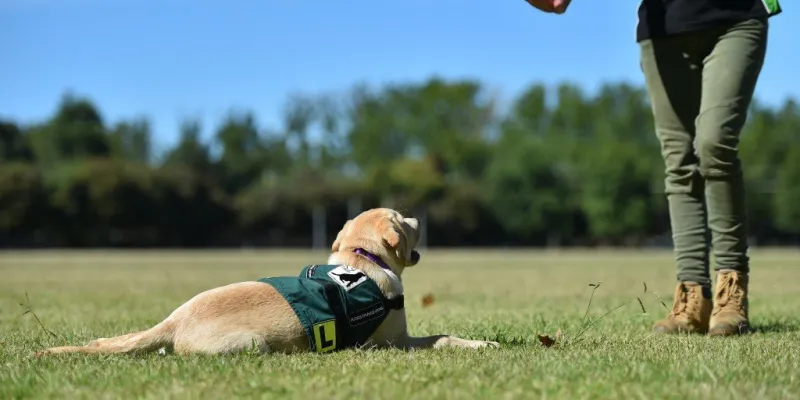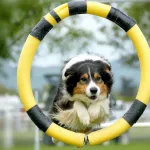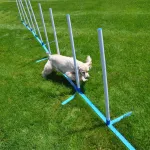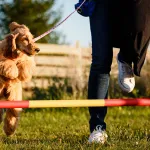Training tips
Therapeutic Mobile Training: Bringing Dog Therapy to Your Doorstep

These animals provide essential emotional and physical support to individuals dealing with various challenges, from mental health issues to physical disabilities. Training a therapy dog or a service dog is a process that requires dedication, patience, and specialized knowledge.
In recent years, the demand for therapy and service dogs has skyrocketed, and for good reason. These animals provide essential emotional and physical support to individuals dealing with various challenges, from mental health issues to physical disabilities. Training a therapy dog or a service dog is a process that requires dedication, patience, and specialized knowledge. Fortunately, mobile training options, like the ones provided by Calidognia, allow for this crucial training to take place in the comfort of one’s own environment. This therapeutic mobile training approach not only personalizes the experience but also makes it convenient and effective.
In this blog, we’ll explore the benefits of therapeutic mobile training, delve into the specifics of training a therapy dog and service dog, and guide you on how to train a therapy dog. Our unique, hands-on approach ensures your dog is fully prepared to bring comfort, assistance, and joy into your life.
The Benefits of Mobile Training for Therapy Dogs
Therapeutic mobile training is a revolutionary approach to therapy dogs training. By bringing the trainer to your doorstep, mobile training provides a personalized setting that can be less stressful for both the dog and the handler. Here are some reasons why mobile training is a preferred choice:
- Familiar Environment: Training a therapy dog in a familiar environment helps it adapt and perform better, as it’s already comfortable in its surroundings.
- Convenience: Mobile training eliminates the hassle of traveling to a training center, saving time and reducing stress for both the dog and the owner.
- Personalized Approach: Every dog is unique, and training should reflect this. A one-on-one session in a familiar environment allows the trainer to create a customized plan that addresses the dog’s specific needs.
- Socialization Opportunities: Since therapy dogs may be required to work in public spaces, mobile training often includes real-world experiences that prepare them for various environments and social interactions.
Training a Therapy Dog: The Basics
Therapy dogs bring comfort and companionship to people in hospitals, nursing homes, schools, and even disaster areas. But what does training therapy dog entail, and what skills are essential? Training therapy dogs often starts with basic obedience skills. Here’s a breakdown of the steps involved in how to train a therapy dog:
1. Basic Obedience Training
- Sit, Stay, Come: Therapy dogs must have solid basic obedience skills. Commands such as “sit,” “stay,” and “come” are essential for controlling the dog in various situations.
- Walking on a Leash: Therapy dogs should be able to walk calmly on a leash without pulling or jumping.
- Focus Training: Teaching a dog to maintain eye contact and focus on its handler is crucial for therapy dogs, as it ensures they stay responsive even in distracting environments.
2. Socialization Skills
- Therapy dogs must be comfortable around strangers, other animals, and various stimuli, like loud noises or sudden movements. Introducing the dog to a wide range of environments during its training helps build resilience and confidence.
3. Emotional Stability and Calmness
- Emotional stability is a core component in therapy dogs training. Therapy dogs are often placed in situations where people may be upset or anxious. Training focuses on keeping the dog calm and ensuring it doesn’t react negatively to stress.
4. Desensitization and Tolerance Training
- Therapy dogs need to tolerate different forms of touch, such as petting or hugging, and should not show aggression or fear. A good therapeutic training program includes desensitization techniques that prepare the dog for different physical interactions.
Training a Service Dog: Unique Requirements
Training a service dog is different from training a therapy dog. Service dogs provide practical assistance to individuals with specific disabilities, from guiding visually impaired people to alerting those with hearing impairments. Here’s what goes into training a service dog:
1. Task-Specific Training
- Service dogs undergo specialized training to perform tasks that assist with their owner’s disability. For example, a service dog trained to aid a person with diabetes may be taught to detect changes in blood sugar levels.
2. Public Access Training
- Unlike therapy dogs, service dogs have the legal right to accompany their handlers into public spaces. This requires extensive training in real-world settings to ensure the dog behaves appropriately in all environments, from crowded streets to quiet libraries.
3. Advanced Obedience Skills
- Training a service dog involves teaching advanced obedience skills that go beyond basic commands. For example, the dog should be able to retrieve items on command, help open doors, or assist its handler in balancing.
4. Sensitivity to Handler’s Needs
- Service dogs are trained to recognize and respond to changes in their handler’s physical or emotional state. For example, they may be taught to nudge their handler during a medical episode, such as an anxiety attack or seizure.
How Therapeutic Mobile Training Works
Therapeutic mobile training for therapy and service dogs starts with an assessment to determine the dog’s strengths, areas for improvement, and any specific needs related to the handler’s goals. Calidognia provides a structured program that covers both foundational obedience and task-specific skills for therapy and service dogs.
Step-by-Step Training Process
Initial Assessment: Our trainers begin with an initial consultation to understand your needs, your dog’s behavior, and any particular goals for training a therapy dog or a service dog.
Customized Training Plan: Based on the assessment, a customized training plan is created to address specific goals, whether it’s therapy dog socialization or service dog task training.
In-Home Training Sessions: Training occurs in your home, creating a low-stress environment for the dog. Our trainers focus on key aspects such as socialization, obedience, and task-specific skills.
Real-World Exposure: We gradually introduce the dog to public settings (if needed for service dog training) to ensure it’s comfortable and reliable in various environments.
Ongoing Support and Reinforcement: Training doesn’t end once the initial sessions are complete. Our team offers continued support to help maintain your dog’s skills over time, ensuring it stays responsive and effective in its role.
Therapy Dog Certification and Requirements
While training a therapy dog at home with mobile services offers convenience, most therapy dogs need to be certified through a recognized organization. The certification process often involves passing a temperament test, which assesses the dog’s behavior and ability to remain calm under pressure. Some therapy dog programs may also require a demonstration of the dog’s obedience and social skills.
Choosing Calidognia for Therapeutic Mobile Training
At Calidognia, we understand the unique bond between therapy or service dogs and their handlers. Our therapeutic mobile training services are designed to support this bond while ensuring your dog is well-prepared to perform its role with confidence. Our experienced trainers bring expertise, compassion, and personalized strategies to every training session, making it easier for you and your dog to reach your goals.
By choosing Calidognia, you’re choosing a service dedicated to creating a supportive and effective training environment for your therapy or service dog. With our approach, training a therapy dog or a service dog is no longer an overwhelming process but an empowering journey for both the dog and handler.




